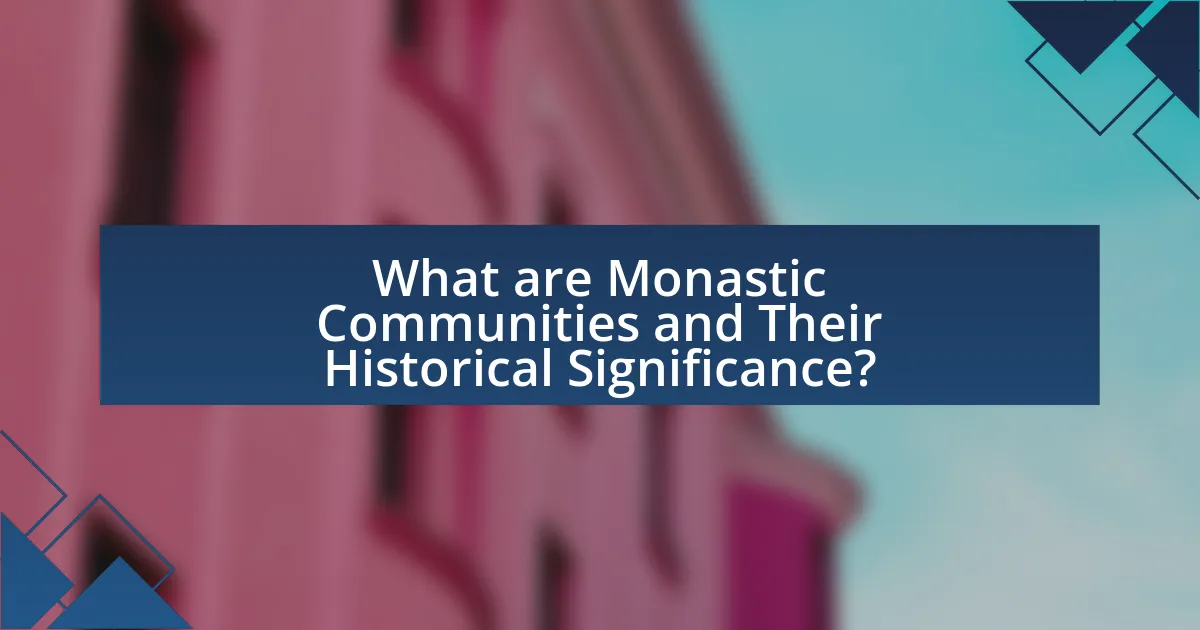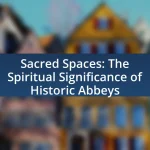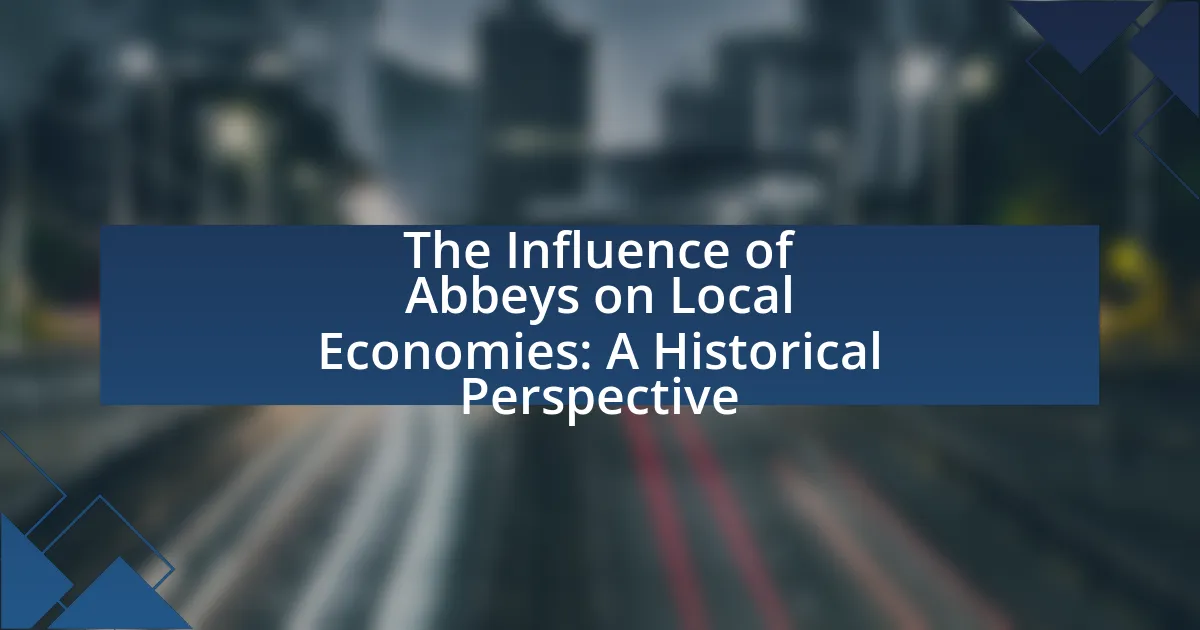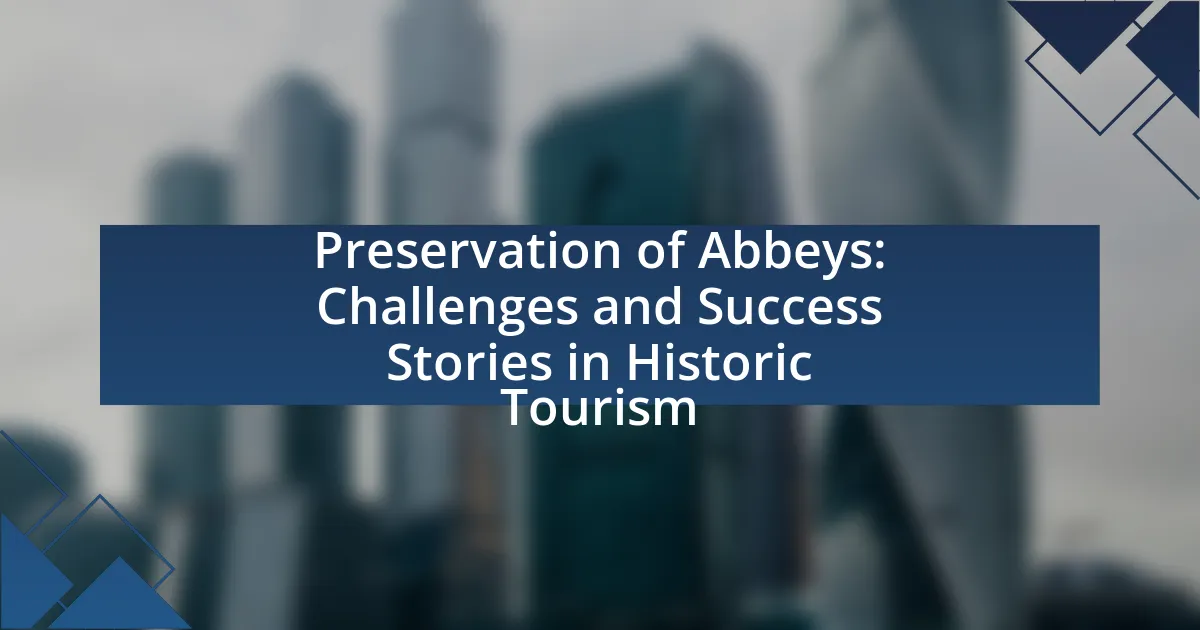Monastic communities, defined as religious groups living under a common rule, have played a pivotal role in shaping European history through their contributions to education, agriculture, and cultural preservation. Emerging in the early Middle Ages, these communities, particularly those following the Rule of St. Benedict, became centers of learning and social services, influencing local economies and governance. They preserved classical texts during the Dark Ages, facilitated agricultural innovations, and engaged in diplomacy, thereby impacting political structures and community life. The lasting effects of monasticism continue to be felt in modern European society, where their values and practices inform contemporary education, social services, and community building.

What are Monastic Communities and Their Historical Significance?
Monastic communities are religious groups that live under a common rule, often characterized by vows of poverty, chastity, and obedience, and they play a significant role in the development of European history. Historically, these communities, such as those following the Rule of St. Benedict, emerged in the early Middle Ages and became centers of learning, agriculture, and cultural preservation. For instance, monasteries were instrumental in copying and preserving classical texts during the Dark Ages, which contributed to the Renaissance. Additionally, they provided social services, such as education and healthcare, and influenced local economies through agricultural innovations. The establishment of monastic orders, like the Cistercians and Franciscans, further shaped religious and social structures across Europe, impacting governance and community life.
How did monastic communities emerge in Europe?
Monastic communities emerged in Europe primarily through the influence of early Christian asceticism and the establishment of monastic rules, notably those by St. Benedict in the 6th century. These communities formed as individuals sought to live a life dedicated to God, often in isolation from secular society, which was characterized by the fall of the Roman Empire and the subsequent social upheaval. The Rule of St. Benedict provided a structured approach to monastic life, emphasizing community living, prayer, and work, which facilitated the growth of monasteries across Europe. By the 8th century, monasticism had become a significant force in European society, contributing to the preservation of knowledge, culture, and agricultural practices during the Middle Ages.
What were the key factors that led to the establishment of monastic communities?
The key factors that led to the establishment of monastic communities include the desire for spiritual devotion, the need for social stability, and the influence of Christian teachings. Spiritual devotion motivated individuals to seek a life dedicated to prayer and asceticism, as exemplified by figures like St. Benedict, whose Rule provided a framework for communal living. Social stability emerged during the decline of the Roman Empire, prompting people to form communities that could provide mutual support and preserve knowledge. Additionally, Christian teachings emphasized the importance of community and shared faith, which encouraged the formation of monastic groups dedicated to serving God and society. These factors collectively contributed to the growth of monasticism, which played a significant role in shaping European history by preserving culture and education during turbulent times.
How did early monasticism influence European society?
Early monasticism significantly influenced European society by establishing centers of learning, preserving knowledge, and promoting agricultural advancements. Monasteries became hubs for education during the early Middle Ages, where monks copied manuscripts and maintained libraries, thus safeguarding classical texts and religious writings. For instance, the Benedictine Rule, established by St. Benedict in the 6th century, emphasized education and literacy among monks, leading to the creation of schools within monastic communities. Additionally, monasteries played a crucial role in agricultural innovation, introducing new farming techniques and crop rotation methods, which improved food production and contributed to the economic stability of the regions they inhabited. This dual role in education and agriculture helped shape the cultural and economic landscape of medieval Europe, fostering a more literate and productive society.
What roles did monastic communities play in medieval Europe?
Monastic communities in medieval Europe served crucial roles in spiritual, educational, agricultural, and social domains. They acted as centers of religious life, providing stability and continuity during periods of political turmoil. Monasteries preserved and copied texts, thus playing a key role in the transmission of knowledge and culture, particularly during the Carolingian Renaissance, when figures like Charlemagne promoted learning. Additionally, monastic communities engaged in agricultural innovations, improving farming techniques and contributing to local economies. They also provided social services, such as care for the poor and sick, which were essential in a time when such support systems were limited. The influence of monastic communities extended beyond their walls, shaping the religious, cultural, and economic landscape of medieval Europe.
How did monastic communities contribute to education and literacy?
Monastic communities significantly contributed to education and literacy by establishing schools and preserving texts. These communities, particularly during the Middle Ages, became centers of learning where monks copied manuscripts, thus safeguarding classical and religious works. For instance, the Benedictine monasteries emphasized education, leading to the creation of scriptoria, where texts were meticulously transcribed. This effort not only maintained literacy among the clergy but also facilitated the spread of knowledge throughout Europe, as many monasteries became the primary educational institutions of their time. The Carolingian Renaissance, initiated by Charlemagne, further exemplified this contribution, as it promoted the establishment of schools within monasteries, enhancing literacy rates among the clergy and laypeople alike.
What impact did monastic communities have on agriculture and economy?
Monastic communities significantly advanced agriculture and the economy by introducing innovative farming techniques and establishing self-sufficient estates. These communities implemented crop rotation, improved plowing methods, and developed irrigation systems, which increased agricultural productivity. For instance, the Cistercian monks in the Middle Ages were known for their effective use of land and water management, leading to higher yields. Additionally, monastic communities often served as centers of trade, producing goods such as wine, cheese, and textiles, which contributed to local economies. Their surplus production not only supported their own needs but also facilitated trade with surrounding regions, thus enhancing economic stability and growth.
Why are monastic communities considered centers of cultural preservation?
Monastic communities are considered centers of cultural preservation because they have historically safeguarded and transmitted knowledge, literature, and traditions through their manuscript copying and educational activities. During the Middle Ages, monasteries became repositories of classical texts and religious writings, preserving works that might have otherwise been lost during periods of turmoil, such as the fall of the Roman Empire. For instance, the Benedictine monks were instrumental in copying and maintaining ancient Greek and Roman texts, which laid the foundation for the Renaissance. Additionally, monastic schools educated generations, ensuring the continuity of cultural and intellectual heritage.
How did monastic communities preserve ancient texts and knowledge?
Monastic communities preserved ancient texts and knowledge primarily through the meticulous practice of copying manuscripts. Monks dedicated themselves to transcribing works from classical antiquity, religious texts, and philosophical writings, ensuring that these materials were not lost to time. For instance, during the Middle Ages, the Benedictine monasteries became centers of learning where monks would spend hours in scriptoria, copying texts by hand, which included works by authors such as Aristotle and Cicero. This effort was crucial, as many ancient texts survived only because they were copied and preserved by these communities, particularly during periods of social upheaval and decline in literacy. The establishment of libraries within monasteries further facilitated the preservation and study of these texts, allowing for the transmission of knowledge across generations.
What artistic contributions did monastic communities make during the Middle Ages?
Monastic communities made significant artistic contributions during the Middle Ages, primarily through the creation of illuminated manuscripts, architecture, and religious art. These communities were centers of learning and preservation, producing intricately decorated texts that included biblical manuscripts and classical works, which were essential for the transmission of knowledge. For example, the Book of Kells, created by Celtic monks around the 9th century, is a renowned example of illuminated manuscript art that showcases elaborate illustrations and calligraphy.
Additionally, monastic architecture, such as the Romanesque and Gothic styles, was heavily influenced by monastic communities, with structures like the Abbey of Cluny and Chartres Cathedral exemplifying their architectural innovations. These buildings not only served religious purposes but also reflected the communities’ artistic aspirations and advancements in engineering. Furthermore, monastic communities contributed to religious art through the creation of altarpieces, frescoes, and sculptures that adorned churches and monasteries, enhancing the spiritual experience of worshippers.
Overall, the artistic contributions of monastic communities during the Middle Ages were pivotal in shaping the cultural and artistic landscape of Europe, preserving and advancing artistic traditions that would influence generations to come.

How did Monastic Communities Influence Political Structures in Europe?
Monastic communities significantly influenced political structures in Europe by serving as centers of education, land management, and political power. These communities, such as the Benedictines and Cistercians, often acquired vast tracts of land through donations and bequests, which allowed them to wield economic power and influence local governance. For instance, monasteries like Cluny became powerful landowners, directly impacting feudal relationships and local politics. Additionally, monks often acted as advisors to kings and nobles, shaping policies and decisions, as seen in the relationship between the Carolingian monarchy and monastic reform movements. Their role in preserving knowledge and promoting literacy also contributed to the development of bureaucratic systems that supported emerging nation-states.
What role did monastic communities play in the feudal system?
Monastic communities played a crucial role in the feudal system by serving as centers of education, agriculture, and economic stability. These communities, such as those following the Benedictine Rule, managed vast tracts of land granted to them by feudal lords, which allowed them to produce food and generate wealth. Monasteries also provided social services, including care for the poor and sick, thus reinforcing their importance in local economies and society. Additionally, they preserved knowledge through the copying of texts, contributing to cultural continuity during the Middle Ages. The influence of monastic communities extended beyond spiritual life, as they often acted as mediators between the nobility and the peasantry, helping to maintain social order within the feudal hierarchy.
How did monastic land ownership affect local power dynamics?
Monastic land ownership significantly altered local power dynamics by concentrating wealth and influence within monastic communities, which often rivaled secular authorities. Monasteries acquired extensive landholdings through donations, bequests, and purchases, leading to their emergence as major economic entities. For instance, during the medieval period, monasteries like Cluny and Cîteaux amassed vast estates, which allowed them to exert considerable political influence and control over local resources. This accumulation of land enabled monastic institutions to engage in agricultural production, generate income, and provide employment, thereby enhancing their status and power in the region. Additionally, the spiritual authority of monastic leaders often positioned them as mediators in local disputes, further entrenching their role in the power structure. Historical records indicate that monastic communities frequently acted independently of local lords, thereby reshaping traditional feudal relationships and contributing to the decentralization of power in certain areas.
What was the relationship between monastic leaders and secular rulers?
Monastic leaders often had a complex and interdependent relationship with secular rulers, characterized by mutual support and occasional conflict. Monastic communities provided spiritual authority and stability, which secular rulers sought to legitimize their power, while rulers offered protection and resources to the monasteries. For example, during the Middle Ages, many kings granted land and privileges to monasteries in exchange for prayers and support, as seen in the relationship between Charlemagne and the Benedictine monasteries. This symbiosis was crucial in shaping European governance and culture, as monastic institutions became centers of learning and agriculture, influencing both religious and secular life.
How did monastic communities engage in diplomacy and conflict resolution?
Monastic communities engaged in diplomacy and conflict resolution primarily through mediation and negotiation, leveraging their neutral status and moral authority. These communities often acted as intermediaries between warring factions, using their influence to promote peace and reconciliation. For example, during the medieval period, monasteries like Cluny played significant roles in resolving disputes among local lords and even between kingdoms, as they were seen as impartial entities dedicated to spiritual rather than temporal power. Historical records indicate that monks frequently facilitated treaties and agreements, such as the Concordat of Worms in 1122, which resolved the Investiture Controversy, showcasing their effectiveness in diplomatic efforts.
What examples exist of monastic communities mediating disputes?
Monastic communities have historically served as mediators in disputes, with notable examples including the Cistercians and the Benedictines. The Cistercian Order, founded in the 12th century, often intervened in local conflicts, leveraging their influence and neutrality to facilitate peace among feuding parties. Similarly, Benedictine monasteries, established in the 6th century, acted as centers of arbitration, where monks would mediate disputes between local lords and communities, promoting reconciliation and stability. These practices were documented in various historical texts, illustrating the significant role monastic communities played in conflict resolution during the medieval period.
How did monastic communities influence the formation of alliances?
Monastic communities influenced the formation of alliances by serving as centers of education, diplomacy, and economic support. These communities often acted as neutral grounds where nobles and leaders could negotiate and forge agreements without the pressures of political rivalry. For instance, monasteries like Cluny in France became influential in the 10th century, promoting peace and cooperation among feudal lords through their networks. Additionally, monastic lands and resources provided economic stability, which encouraged alliances through mutual support and shared interests. The establishment of the Peace of God movement, initiated by monastic leaders, further exemplified how these communities sought to reduce violence and promote alliances among local powers, thereby shaping the political landscape of medieval Europe.

What are the Lasting Impacts of Monastic Communities on Modern Europe?
Monastic communities have significantly influenced modern Europe through their contributions to education, agriculture, and preservation of knowledge. These communities established some of the first schools and universities, such as the University of Bologna in 1088, which laid the groundwork for the modern educational system. Additionally, monastic farms introduced advanced agricultural techniques, such as crop rotation and animal husbandry, which improved food production and sustainability. Furthermore, monasteries played a crucial role in preserving ancient texts and manuscripts during the Middle Ages, ensuring the survival of classical knowledge that would later fuel the Renaissance. These lasting impacts demonstrate how monastic communities have shaped various aspects of contemporary European society.
How do monastic communities continue to influence contemporary society?
Monastic communities continue to influence contemporary society through their contributions to education, social services, and cultural preservation. These communities often establish schools and educational institutions, promoting literacy and learning, which can be traced back to the medieval period when monasteries were centers of knowledge. For example, the Benedictine monks founded numerous schools across Europe, laying the groundwork for modern educational systems. Additionally, many monastic communities engage in social outreach, providing services such as food banks, shelters, and healthcare, reflecting their commitment to community welfare. Their role in preserving cultural heritage is evident in the maintenance of historical texts, art, and architecture, which informs contemporary cultural identity. Thus, the ongoing impact of monastic communities is evident in various facets of modern life, reinforcing their historical significance.
What modern institutions trace their origins back to monastic communities?
Modern institutions that trace their origins back to monastic communities include universities, hospitals, and charitable organizations. Universities, such as the University of Bologna and the University of Paris, evolved from monastic schools established for the education of clergy. Hospitals, like St. Bartholomew’s Hospital in London, originated from monastic infirmaries that provided care for the sick and poor. Charitable organizations also developed from monastic practices of almsgiving and community support, reflecting the monastic commitment to service and education.
How do monastic values manifest in today’s social and cultural practices?
Monastic values manifest in today’s social and cultural practices through community service, mindfulness, and simplicity. Many contemporary organizations and movements, such as mindfulness-based stress reduction programs, draw inspiration from monastic traditions that emphasize meditation and self-reflection. Additionally, the rise of intentional communities and co-housing initiatives reflects the monastic commitment to communal living and shared resources, promoting social cohesion and sustainability. The practice of minimalism in lifestyle choices also echoes monastic values, as individuals seek to reduce material excess and focus on spiritual and personal growth. These manifestations illustrate the enduring influence of monastic principles in shaping modern societal norms and cultural practices.
What lessons can be learned from the history of monastic communities?
The history of monastic communities teaches the importance of community, discipline, and preservation of knowledge. Monastic communities, such as those established by St. Benedict in the 6th century, emphasized communal living and shared responsibilities, which fostered a sense of belonging and cooperation. Additionally, the strict adherence to routines and spiritual practices cultivated discipline among members, contributing to personal and communal growth. Furthermore, monasteries played a crucial role in preserving classical texts and advancing education during the Middle Ages, as seen in the establishment of scriptoria where monks copied manuscripts. This preservation of knowledge was vital for the intellectual revival in Europe, particularly during the Renaissance.
How can the principles of monastic life be applied to modern challenges?
The principles of monastic life can be applied to modern challenges by emphasizing community, mindfulness, and simplicity. Monastic communities historically fostered a sense of belonging and support, which can address contemporary issues like social isolation and mental health crises. For instance, the practice of communal living and shared responsibilities can enhance social cohesion and provide emotional support in today’s fragmented society. Additionally, the monastic focus on mindfulness and meditation can help individuals manage stress and improve mental well-being, as evidenced by studies showing that mindfulness practices reduce anxiety and depression. Lastly, the principle of simplicity encourages individuals to prioritize essential values over materialism, which can combat consumerism and promote sustainable living in a world facing environmental challenges.
What best practices from monastic communities can enhance community building today?
Best practices from monastic communities that can enhance community building today include fostering a sense of shared purpose, practicing regular communal activities, and emphasizing hospitality. Monastic communities historically thrived on a collective mission, which created strong bonds among members; this shared purpose can be replicated in modern communities to enhance collaboration and commitment. Regular communal activities, such as shared meals and group prayers, have been shown to strengthen relationships and build trust, as evidenced by studies indicating that shared experiences foster deeper connections. Additionally, the practice of hospitality, where monastic communities welcomed outsiders, can encourage inclusivity and openness in contemporary settings, promoting a culture of acceptance and support.




